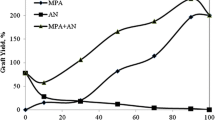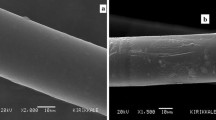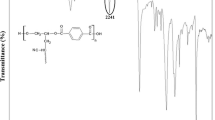Abstract
Poly(ethylene terephthalate) fibers (PET) were grafted with 4-vinyl pyridine (4-VP) by a chemical grafting technique, and an N-oxide derivative was synthesized (N-oxide-4-VP-g-PET). The removal of methylene blue (MB) from the aqueous solutions by this material was investigated. The removal and desorption capacities for MB dye were studied under various conditions. 4-VP-g-PET fibers exhibited a very low removal rate when compared to the basic dye; however, N-oxide-4-VP-g-PET fibers showed more increased removal results. 2.5% of the MB dyes removal was observed with 4-VP-g-PET fibers, while 100% of MB dyes removal was found with N-oxide-4-VP-g-PET fibers using 10 ppm of MB solution. Removal capacity of N-oxide-4-VP-g-PET fibers increased with increasing pH values. The maximum removal capacity of MB dye on the N-oxide-4-VP-g-PET fibers was found to be 35.1 mg g−1 at 250 ppm. Results showed that removal capacity of 4-VP-g-PET fibers was significantly improved by N-oxide functionalization. Almost all adsorbed dyes were eluted by acetic acid in methyl alcohol. Ten removal–desorption cycles indicated that the reactive fibers were favorable for use again without the notable change in removal capacity. The information gained from these studies showed that the N-oxide-4-VP-g-PET fibers demonstrated potential as an effective adsorbent for the extremely effective removal of cationic dyes from aqueous media.










Similar content being viewed by others
References
Üner O, Geçgel Ü, Bayrak Y (2016) Adsorption of methylene blue by an efficient activated carbon prepared from citrullus lanatus rind: kinetic isotherm thermodynamic and mechanism analysis. Water Air Soil Pollut 227(7):247–257
Yagub MT, Sen TK, Ang HM (2012) HM equilibrium kinetics and thermodynamics of methylene blue adsorption by pine tree leaves. Water Air Soil Pollut 223(8):5267–5282
Asamoto H, Kimura Y, Ishiguro Y, Minamisawa H, Yamada K (2016) Use of polyethylene films photografted with 2-(dimethylamino)ethyl methacrylate as a potential adsorbent for removal of chromium (VI) from aqueous medium. J Appl Polym Sci 133(18):43360–43370
Arslan M (2010) Use of 16-diaminohexane-functionalized glycidyl methacrylate-g-poly(ethylene terephthalate) fiber for removal of acidic dye from aqueous solution. Fiber Polym 11(2):177–184
Coşkun R, Soykan C, Saçak M (2006) Removal of some heavy metal ions from aqueous solution by adsorption using poly(ethylene terephthalate)-g-itaconic acid/acrylamide fiber. React Funct Polym 66(6):599–608
Coşkun R, Soykan C, Saçak M (2006) Adsorption of copper(II) nickel(II) and cobalt(II) ions from aqueous solution by methacrylic acid/acrylamide monomer mixture grafted poly(ethylene terephthalate) fiber. Sep Purif Technol 49(2):107–114
Choi SH, Nho YC (1999) Adsorption of Pb2+ Cu2 + and Co2+ by polypropylene fabric and polyethylene hollow fiber modified by radiation-induced graft copolymerization. Korean J Chem Eng 16(2):241–247
Yiğitoğlu M, Arslan M (2007) 4-Vinylpyridine and 2-hydroxyethylmethacrylate monomer mixture graft copolymerization onto poly(ethylene terephthalate) fibers using benzoyl peroxide. Polym Bull 58(5):785–798
Sacak M, Sertkaya F, Talu M (1992) Grafting of poly(ethylene terephthalate) fibers with methacrylic acid using benzoyl peroxide. J Appl Polym Sci 44(10):1737–1742
Nasef MM (2000) Gamma radiation-induced graft copolymerization of styrene onto poly(ethylene terephthalate) films. J Appl Polym Sci 77(5):1003–1012
Arslan M, Yiğitoğlu M, Sanli O, Ünal HI (2003) Kinetics of swelling assisted grafting of 4-vinyl pyridine onto poly(ethylene terephthalate)fibers using a benzoyl peroxide initiator. Polym Bull 51(3):237–244
Coşkun R, Soykan C (2009) Preparation of amidoximated polyester fiber and competitive adsorption of some heavy metal ions from aqueous solution onto this fiber. J Appl Polym Sci 112(3):1798–1807
Temoçin Z, Yiğitoğlu M (2009) Studies on the activity and stability of immobilized horseradish peroxidase on poly(ethylene terephthalate) grafted acrylamide fiber. Bioproces Biosyst Eng 32(4):467–474
Neagu V, Mikhalovsky S (2010) Removal of hexavalent chromium by new quaternized crosslinked poly(4-vinylpyridines). J Hazard Mater 183(1–3):533–540
Neagu V (2009) Removal of Cr(VI) onto functionalized pyridine copolymer with amide groups. J Hazard Mater 171(1–3):410–416
Jermakowicz-Bartkowiak D, Kolarz BN (2011) Poly(4-vinylpyridine) resins towards perrhenate sorption and desorption. React Funct Polym 71(2):95–103
Coşkun R (2011) Removal of cationic dye from aqueous solution by adsorption onto crosslinked poly(4-vinylpyridine/crotonic acid) and its N-oxide derivative. Polym Bull 67(1):125–140
Lee CM, Pearce EM, Kwei TK (1996) Viscosity and light scattering studies of poly(4-vinylpyridine N-oxide) in solution. Polymer 37(19):4283–4288
Dod R, Banerjee G, Saini DR (2015) Removal of methylene blue (MB) dye from water environment by processed Jowar Stalk [Sorghum bicolor (L,) Moench] adsorbent. Clean Technol Environ Policy 17(8):2349–2359
Arslan M, Günay K (2017) Synthesis and characterization of PET fibers grafted with binary mixture of 2-methylpropenoic acid and acrylonitrile by free radical: its application in removal of cationic dye. Polym Bull 74(4):1221–1236
Arslan M, Yigitoglu M (2008) Use of methacrylic acid grafted poly(ethylene terephthalate) fibers for the removal of basic dyes from aqueous solutions. J Appl Polym Sci 110(1):30–38
Author information
Authors and Affiliations
Corresponding author
Rights and permissions
About this article
Cite this article
Arslan, M., Günay, K. Application of 4-VP-g-PET fibers and its N-oxide derivative as an adsorbent for removal of cationic dye. Polym. Bull. 76, 953–965 (2019). https://doi.org/10.1007/s00289-018-2400-4
Received:
Revised:
Accepted:
Published:
Issue Date:
DOI: https://doi.org/10.1007/s00289-018-2400-4




